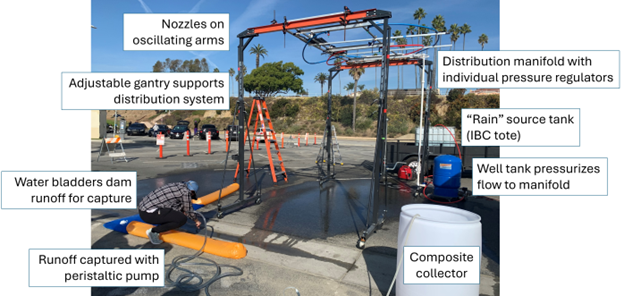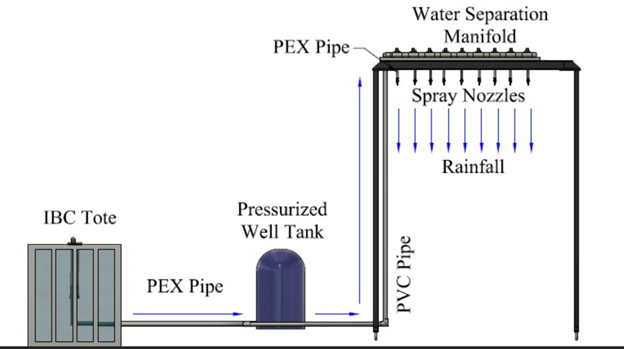To pursue the SMC’s street sweeping study, researchers’ first step was to develop a robust study design that could quantify street sweeping’s effectiveness for removing roadway pollution. This step has stymied prior efforts to measure street sweeping’s role, as any data generated through the method need to be reproducible and representative.
Thus, the SMC’s study design involved controlling the unpredictable timing, intensity and duration of real-life wet-weather events through simulated rainfall. Researchers designed and custom-built a rainfall generator capable of simulating rainfall at a controlled rate and duration across about 74 square feet of surface area; the simulated rainfall was designed to mimic rainfall energies typical for Southern California.

The approach enables researchers to eliminate variability due to both climate (e.g., rainfall frequency, rainfall impact energy, intensity, etc.) and environment (e.g., limit runoff generation to street/pavement area only).
Full design specifications for the field-deployable instrument, which is envisioned to have widespread utility beyond the street sweeping study, are publicly accessible online and will be published in a forthcoming journal article.
Once the rainfall generator was operational, researchers isolated segments of a parking lot in Long Beach. One side of the parking lot was swept, while the other side that served as the experimental control was not swept. Initial testing was conducted in a parking lot to simplify the logistics of evaluating the methodology itself. Researchers recognize that the efficacy of street sweeping may differ between parking lots and municipal streets, and are keen to conduct broader testing.
Researchers used the rainfall generator to simulate rainfall on both pavement segments, then looked for differences in the pollutant levels from the generated runoff. Based on data from this single site, researchers were able to identify quantifiable differences in the levels of pollutants in runoff from the swept vs. unswept pavement segments.
The work was led by the Southern California Coastal Water Research Project (SCCWRP), which is an SMC member agency.
While the initial pilot work was conducted in a parking lot, the SMC is planning a follow-up study that is expected to conduct future evaluations on actual roadways.

